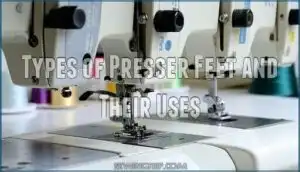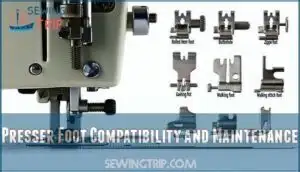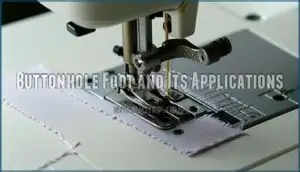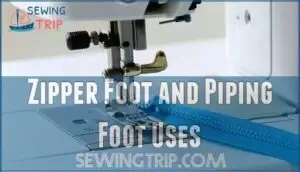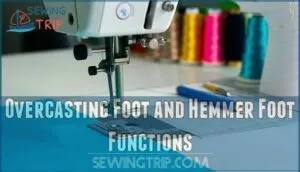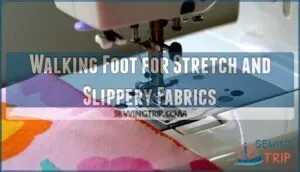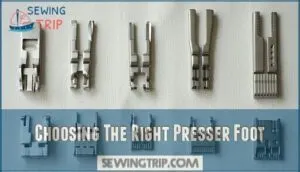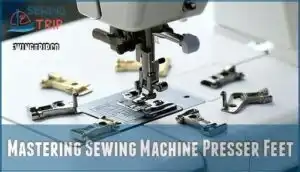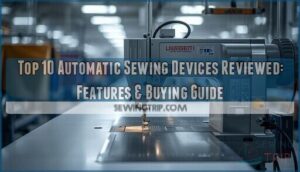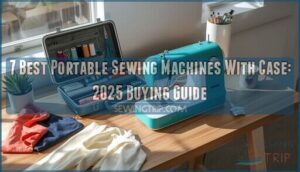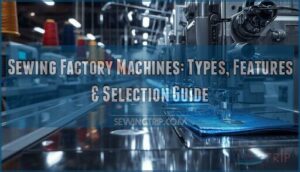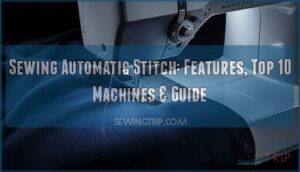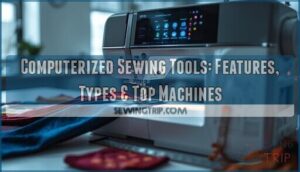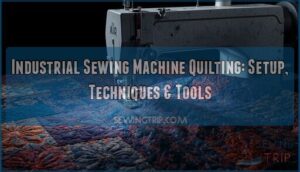This site is supported by our readers. We may earn a commission, at no cost to you, if you purchase through links.
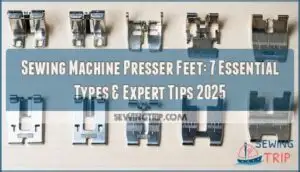 Sewing machine presser feet are small attachments that hold fabric against your machine’s feed dogs while you stitch.
Sewing machine presser feet are small attachments that hold fabric against your machine’s feed dogs while you stitch.
You’ll find dozens of types, each designed for specific tasks. The basic zigzag foot handles everyday sewing, while specialized feet tackle buttonholes, zippers, and hems.
Most machines use either low-shank or high-shank systems, so you need compatible feet. A walking foot helps with stretchy or slippery fabrics, and an overcast foot finishes edges professionally.
Think of sewing machine presser feet as your specialized toolkit – each one solves different fabric challenges. Choosing the right foot transforms frustrating projects into smooth, professional results with cleaner stitches and better control.
Table Of Contents
Key Takeaways
- You’ll need to check your machine’s shank type (low-shank or high-shank) before buying presser feet, as most universal feet work with low-shank machines but high-shank models require adapters for compatibility.
- You can transform your basic sewing machine into a versatile powerhouse by investing in specialty feet like walking feet for stretchy fabrics, zipper feet for close stitching, and buttonhole feet for professional closures.
- You’ll get the best results by matching your presser foot to your specific fabric type and sewing technique – using the wrong foot leads to uneven stitches, fabric damage, and frustrating project outcomes.
- You can save money and expand your capabilities by purchasing comprehensive presser foot sets (32-48 pieces) rather than buying individual feet, giving you professional-grade tools at a fraction of the cost.
Sewing Machine Presser Feet Basics
Your sewing machine’s presser foot holds fabric in place and guides it through the machine while you stitch, making it one of the most important parts for creating even, neat seams.
Your presser foot is the unsung hero that transforms chaotic fabric into perfect, professional seams every time.
You’ll find over 30 different types of presser feet available, each designed to handle specific tasks like zippers, buttonholes, and hemming with greater accuracy than using just the basic foot.
Presser Foot Functions and Importance
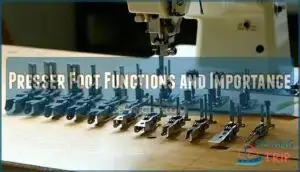
Your presser foot acts as the unsung hero of every sewing project, controlling fabric feed while maintaining stitch consistency.
The presser foot: your sewing machine’s silent partner that transforms chaotic fabric into perfectly aligned masterpieces.
This essential component provides finger safety by keeping your hands away from the needle.
Through precise pressure control, it enables various sewing techniques across different fabric types.
Understanding presser foot function transforms your sewing machine feet from basic tools into technique enablement powerhouses that elevate your craftsmanship.
Types of Presser Feet and Their Uses
Understanding sewing machine presser feet opens up countless creative possibilities.
Each foot serves a specific purpose, transforming your machine into a versatile tool for different techniques and fabrics.
Here’s your essential Specialty Foot Guide for common presser foot types:
- All-Purpose Foot – Perfect for straight stitching and basic zigzag work
- Zipper Foot – Allows close stitching alongside zippers and piping
- Buttonhole Foot – Creates consistent, professional buttonholes automatically
- Walking Foot – Feeds multiple fabric layers evenly through tricky materials
To verify compatibility, it’s vital to understand low and high shanks.
Presser Foot Compatibility and Maintenance
Before diving into your sewing projects, you’ll need to master presser foot compatibility and maintenance.
Most sewing machine presser feet work with low-shank machines, but high-shank models need adapters.
Regular cleaning methods prevent fabric buildup, while proper storage solutions keep feet organized.
Check wear indicators regularly—worn feet create uneven stitches.
| Compatibility Factor | Low-Shank Machines | High-Shank Machines |
|---|---|---|
| Shank Height | 3/4 inch standard | 1+ inch requires adapter |
| Adapter Usage | Not needed | Universal adapter required |
| Foot Variety | Most presser feet fit | Limited compatibility |
| Brand Options | Generic sets work well | Brand-specific often needed |
Top 7 Sewing Machine Presser Feet
You’ll find these seven presser feet handle most of your sewing projects, from basic straight stitches to complex decorative work.
Each foot serves a specific purpose, and knowing which one to use makes your sewing faster and more accurate.
1. Sewing Machine Presser Feet Low Shank
Low-shank compatibility makes these feet your sewing machine’s best friends.
You’ll find they fit over 80% of domestic machines, including Brother, Singer, and Janome models.
The 3/4-inch measurement from foot bottom to screw hole defines low-shank systems.
These versatile attachments snap on easily and handle everything from straight stitching to decorative work.
You can’t use high-shank feet on low-shank machines, so always check compatibility first.
A low shank sewing machine typically has a shank height of 0.75 inches or less.
They’re affordable, reliable, and transform your basic machine into a powerhouse for countless sewing projects.
Best For: Beginners and experienced sewers looking for a cost-effective, versatile set of presser feet compatible with most low-shank machines.
- Affordable alternative to original machine feet with no major quality differences.
- Includes a wide variety of presser feet for diverse sewing projects.
- Compatible with over 80% of domestic low-shank sewing machines.
- Manual not available in French, requiring reliance on online tutorials.
- Some users reported cases of missing or mislabeled presser feet.
- Case quality and organization could be improved.
2. 42 Piece Sewing Machine Presser Feet
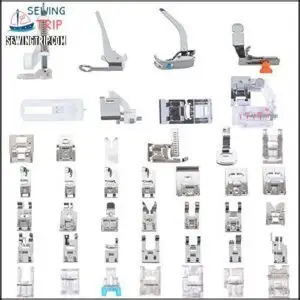
You’ll find exceptional value in this extensive 42-piece presser foot collection.
This set transforms your low-shank sewing machine into a versatile powerhouse, compatible with Brother, Singer, Viking, and Janome models.
The durable zinc alloy construction guarantees long-lasting performance, while the organized plastic case keeps everything visible and accessible.
At $39.95 (regularly $49.95), you’re getting specialty feet for quilting, embroidery, zippers, and buttonholes, which is like having a complete sewing toolkit that fits in your palm—perfect for expanding your creative possibilities without breaking the bank.
Best For: Hobbyists and experienced sewers looking to expand their sewing capabilities with a cost-effective, versatile presser foot set.
- Not suitable for vintage, mini, or industrial sewing machines.
- Some feet may not align perfectly with all sewing machines.
- Occasional issues with duplicates or missing feet in the set.
- Compatible with most low-shank sewing machines like Brother, Singer, and Janome.
- Durable zinc alloy construction ensures long-lasting performance.
- Includes specialty feet for quilting, embroidery, zippers, and buttonholes.
3. Sewing Machine Presser Feet 48pcs Set
The 48-piece presser foot set takes your sewing game to the next level with premium zinc alloy construction.
You’ll get incredible value at $66 compared to buying individual feet.
This extensive collection handles everything from leather work to delicate embroidery, fitting most low shank machines including Brother, Singer, and Janome models.
The durable material prevents fabric damage while ensuring smooth operation for years.
Whether you’re tackling buttonholes, installing zippers, or creating decorative stitches, this versatile set has you covered.
Best For: Beginner and advanced sewers looking for an affordable, versatile set of presser feet to tackle a variety of sewing projects.
- Some users report issues with fit and quality control.
- Lack of clear labeling and similar-looking feet can be confusing for beginners.
- Incompatible with some machines like Janome 9850.
- Durable zinc alloy construction ensures smooth and precise operation.
- Compatible with major low shank domestic sewing machine brands.
- Suitable for diverse applications like leatherwork, embroidery, and zippers.
4. Sewing Machine Presser Foot Set
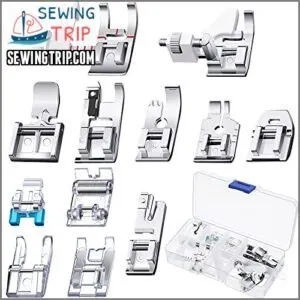
Extensive presser foot sets transform your sewing experience with professional-grade tools.
You’ll receive 32 of the most popular feet designed for straight stitching, zipper installation, and decorative embellishments.
These sets include durable plastic storage containers with padded inserts to keep everything organized.
Quality construction guarantees long-lasting performance across various projects.
Detailed instructions, online manuals, and tutorial videos help you achieve professional results.
Whether you’re hemming garments or creating intricate quilting patterns, these complete sets provide the versatility needed for advanced sewing techniques.
Best For: Sewing enthusiasts, beginners, and experienced crafters wanting to enhance precision, efficiency, and creativity in their projects.
- Not compatible with all sewing machine types like mini or industrial models.
- May have a learning curve for complete beginners.
- Some users may not need all the included presser feet.
- Includes 32 versatile presser feet for various sewing techniques.
- Comes with durable storage for easy organization.
- Provides instructions and tutorials for skill-building assistance.
5. Sewing Machine Presser Feet Set
The Ultimate Presser Foot Set transforms your sewing machine into a versatile powerhouse.
You’ll get 32 essential feet in one compact box, covering everything from buttonholes to decorative stitching.
This set works with Singer, Brother, Janome, Kenmore, and Babylock low-shank machines.
At $29.99, it’s a steal compared to buying individual feet.
The 4.8-star rating from 147 customers speaks volumes about quality.
You’ll find specialized feet for blind hems, zippers, and reverse-feed stitching that’ll elevate your sewing game substantially.
Best For: Sewing enthusiasts and professionals seeking a wide variety of presser feet for versatile sewing projects.
- Includes 32 essential presser feet in one compact set.
- Broad compatibility with popular low-shank sewing machine brands.
- High customer satisfaction with a 4.8-star rating from 147 reviews.
- Some presser feet may be challenging for beginners to use effectively.
- Not compatible with high-shank or industrial sewing machines.
- Limited information on durability over extended use.
6. Zig Zag Sewing Machine Presser Feet
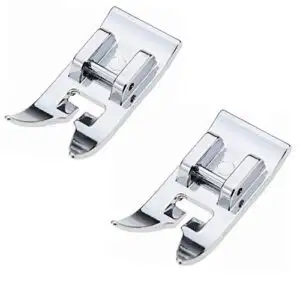
The zig zag presser foot is your sewing machine’s Swiss Army knife.
This versatile attachment handles straight stitches, zigzag patterns, and decorative stitching with ease.
You’ll find it’s the most useful foot in your collection, perfect for general sewing tasks and basic mending.
The wide needle slot accommodates stitches up to 7mm wide, making it ideal for elastic insertion and fabric finishing.
Most machines include this all-purpose foot as standard equipment.
Its clear design lets you watch your stitches develop perfectly.
Best For: Beginners and experienced sewers needing a versatile, easy-to-use presser foot for general sewing and decorative stitching.
- Handles multiple stitch types, including straight and zigzag.
- Wide needle slot accommodates stitches up to 7mm.
- Clear design allows for precise stitch monitoring.
- May not fit machines without a snap-on shank system.
- Not specialized for heavy-duty or thick fabrics.
- Requires compatibility with low-shank machines only.
7. SINGER Even Feed Walking Foot
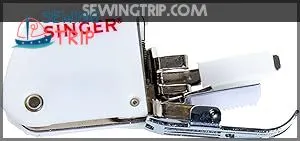
When thick fabrics fight back, the SINGER Even Feed Walking Foot becomes your secret weapon.
This metal powerhouse features its own feed dogs that work alongside your machine’s system, creating synchronized fabric movement. You’ll tackle heavyweight materials like canvas and vinyl without puckering or shifting.
The foot excels at quilting projects and pattern matching, keeping stripes perfectly aligned.
Compatible with SINGER CA, CB, EA, MA, and MB series machines, it transforms challenging sewing tasks into smooth operations.
At 2.24 ounces, it’s lightweight yet durable enough for professional results.
Best For: Quilters, crafters, and sewing enthusiasts who work with thick or layered fabrics and need precise stitching.
- Smooth fabric feeding for professional results.
- Durable metal construction with its own feed dogs.
- Ideal for quilting, pattern matching, and heavyweight materials.
- Compatibility issues with some machines.
- Occasional adjustments needed for certain fabrics.
- Requires regular lubrication for optimal performance.
Presser Foot Specialized Functions
Each presser foot you’ll use has a specific job that makes certain sewing tasks much easier and more accurate.
You’ll discover how buttonhole feet create perfect openings, zipper feet handle tight spaces, and walking feet manage tricky fabrics that slip or stretch.
Buttonhole Foot and Its Applications
Several buttonhole types work best when you match your buttonhole foot to specific fabric considerations.
This essential member of sewing machine presser feet transforms complex tasks into simple steps.
- Stabilization techniques prevent fabric puckering during stitching
- Button size determines your buttonhole length settings
- Foot adjustments customize width for different thread weights
- Fabric considerations guide your stitch density choices
- Buttonhole types include standard, keyhole, and stretch varieties
Zipper Foot and Piping Foot Uses
Your zipper foot and piping foot work like precision tools for detailed sewing tasks.
The zipper foot slides close to zipper teeth, handling regular and invisible zippers with simple foot adjustments. Meanwhile, your piping foot creates perfect corded edges and decorative trim.
Both presser feet types transform tricky techniques into manageable projects. You can find various foot options online.
| Foot Type | Primary Use | Key Feature |
|---|---|---|
| Zipper Foot | Installing zippers | Adjustable positioning |
| Piping Foot | Creating corded edges | Groove guides cord |
Overcasting Foot and Hemmer Foot Functions
Raw fabric edges need proper finishing, and that’s where your overcasting foot shines.
This specialized attachment creates clean edge finishing on seams, preventing fraying with overlock-style stitches.
Meanwhile, your hemmer foot tackles rolled hems in various hemmer sizes, from narrow ¼-inch to wider options.
Both sewing machine presser feet require regular foot maintenance—clean thread buildup weekly for peak performance in your sewing foot guide.
Walking Foot for Stretch and Slippery Fabrics
When working with stretchy or slippery materials, your walking foot becomes your best friend.
This specialty presser foot grips fabric from above while feed dogs pull from below, preventing slippage during stitching. The dual feeding system applies even pressure, making it perfect for quilting applications and tricky fabrics.
Regular walking foot maintenance keeps your sewing machine feet performing flawlessly. For even feeding, consider using specialized presser feet to ensure even pressure and prevent issues with slippage.
Choosing The Right Presser Foot
You’ll need to match your presser foot to your specific sewing task and fabric type to get the best results.
Consider your machine’s shank type, the project you’re working on, and whether you need a basic foot or specialty attachment before making your choice.
Factors to Consider When Selecting Presser Feet
Choosing the right sewing machine presser feet depends on several key factors that’ll make or break your projects.
Here’s what you need to keep in mind:
- Shank Height – Check if your machine uses high or low shank before buying presser foot types
- Fabric Type – Different materials require specific sewing machine feet for best results
- Stitch Type – Match your presser foot selection to planned stitching techniques
- Budget Options – Quality sewing machine presser feet don’t always mean expensive
Presser Foot Brands and Manufacturers
When you’re shopping for sewing machine presser feet, brand reputation matters.
BERNINA and PFAFF lead with precision engineering, while Singer offers affordable options.
MadamSew provides universal compatibility across most machines.
Manufacturing processes vary between brands – some prioritize durability, others focus on cost-effectiveness.
Foot materials range from basic plastic to premium metal construction, affecting pricing strategies and overall performance.
High-quality options are available for specific BERNINA models.
Universal Presser Feet and Their Compatibility
Most sewing machine presser feet work with low-shank machines like Brother and Janome models.
High-shank machines need specific adapter usage to fit universal feet, and brand variations exist, but snap-on feet offer excellent multi-machine usage across different manufacturers.
Check your sewing machine compatibility by measuring the shank height, as universal sewing machine feet types simplify presser foot selection for multiple projects.
Specialty Presser Feet for Advanced Techniques
Advanced sewers discover new possibilities with specialty presser feet designed for complex fabric manipulation.
Applique techniques become effortless with clear open-toe feet, while darning mastery requires specialized darning feet.
Knit footwork improves with stretch-specific attachments, and satin stitching achieves professional results through dedicated feet.
Stitch guides help maintain precision during intricate sewing techniques, transforming your machine’s capabilities. Finding the correct presser feet can greatly improve sewing outcomes with the right presser feet.
Mastering Sewing Machine Presser Feet
Now that you’ve learned about different presser foot types and how to choose the right ones, it’s time to master the skills that’ll make you confident with every attachment.
You’ll discover how to change presser feet quickly, keep them in good condition, and avoid the common mistakes that can slow down your sewing projects, which will help you become more efficient.
How to Change and Use Presser Feet
Mastering sewing machine feet starts with understanding the basics. Most modern machines use snap-on attachments that click into place with a simple push.
Here’s your step-by-step approach:
- Attaching Feet: Raise the presser foot lever, remove the old foot by pressing the release button, and snap the new specialty presser feet into position
- Foot Alignment: Check that your sewing machine feet sit flat against the fabric and align properly with the needle position
- Tension Adjustment: Test stitch settings on scrap fabric, adjusting thread tension and fabric feeding as needed for ideal results
Tips for Maintaining and Storing Presser Feet
Once you’ve mastered changing presser feet, proper care keeps them working perfectly.
Clean your sewing machine feet regularly with a soft brush to remove lint and thread buildup.
Store them in a sewing machine feet organizer or tackle box with labeled compartments.
Check compatibility before purchasing new feet, and always reference your manual for specific cleaning methods and damage prevention tips.
Common Mistakes to Avoid When Using Presser Feet
Don’t force the wrong foot onto your machine – incorrect attachment damages both parts.
Check your shank height before buying new feet. Adjust foot pressure for different fabrics or you’ll get uneven stitches.
Never ignore tension adjustment when switching feet. Poor fabric feeding happens when you rush the process.
These sewing machine feet guide basics prevent costly repairs and frustrating results.
Fabric slippage can occur if you don’t address presser foot pressure.
Frequently Asked Questions (FAQs)
Do all presser feet fit all sewing machines?
No, presser feet don’t fit all machines.
You’ll need to check if your machine uses high-shank or low-shank feet.
Universal feet work with most low-shank machines, but some brands require specific attachments.
Are sewing machine presser feet universal?
Most presser feet aren’t truly universal, but many are compatible across brands. You’ll need to check if your machine uses high-shank or low-shank feet, then match accordingly for proper fit.
What is the most useful sewing machine foot?
Like a trusty Swiss Army knife in your sewing toolkit, the all-purpose presser foot reigns supreme.
You’ll use it for straight seams, zigzag stitches, and basic hemming.
It’s your go-to foot that handles most everyday sewing tasks.
What is presser foot J for?
You’ll find presser foot J is typically a buttonhole foot on most sewing machines.
It creates clean, precise buttonholes by guiding fabric and controlling stitch width automatically, making professional-looking closures simple for your garment projects.
Can I use presser feet on vintage machines?
Vintage machines often accept universal presser feet, but you’ll need to check if yours has high or low shank compatibility.
Most standard feet work perfectly, though some older machines require specific vintage attachments.
Do presser feet affect thread tension settings?
Thread tension typically stays constant regardless of your presser foot choice.
However, specialty feet like walking or Teflon feet can slightly reduce fabric drag, which might require minor tension adjustments for superior stitch quality.
This adjustment is crucial for achieving superior stitch quality, especially when working with delicate or thick fabrics.
How often should presser feet be replaced?
Presser feet don’t need regular replacement unless they’re damaged, worn, or bent.
Quality feet can last decades with proper care.
You’ll know it’s time when stitches become uneven or fabric doesn’t feed smoothly anymore.
Can damaged presser feet harm my fabric?
Like a bent needle wreaking havoc on silk, damaged presser feet can snag, tear, or stretch your fabric.
Scratched surfaces, worn edges, and loose parts create uneven pressure, causing puckering and poor stitches that’ll ruin your project, due to uneven pressure.
Are expensive presser feet worth the investment?
Quality feet last longer and perform more consistently than cheap alternatives.
You’ll see better stitch results, fewer fabric snags, and smoother operation.
If you sew regularly, investing in durable feet saves money long-term.
Conclusion
Mastering sewing machine presser feet is like discovering a treasure chest of possibilities for your projects.
You’ve discovered seven essential types that’ll transform your sewing experience from frustrating struggles to smooth successes.
Remember to match your presser foot to your fabric and technique for best results.
Whether you’re tackling buttonholes, zippers, or stretchy materials, the right foot makes all the difference.
Start with basic feet, then expand your collection as your skills grow.
Your sewing adventures await!
- https://www.wawak.com/sewing/sewing-machine-parts-accessories/sewing-machine-feet/?srsltid=AfmBOorBnRNKN9U98-8GOXi8OXR1HTH8yTOdIJ6qqwsjbFuCzp3qD_-k
- https://www.sewessential.co.uk/blog/sewing-machine-presser-feet-guide/
- https://madamsew.com/collections/presser-feet?srsltid=AfmBOoof2w6Gj5092NQJCCfickTHteTnHD4YSaovXvkrOa0EqVG5BjZt
- https://www.creativefeet.com/?srsltid=AfmBOorf7MkSg-p5g-oZVyaQy_O-9Y03z2SzDqw9pRgK0-nmDnp8EfUt
- https://www.singer.com/collections/pfaff-presser-feet-attachments?srsltid=AfmBOopl7maOgt0btIMf2fE7GZJ_RaDkHUBW1vGSZ0F0JVJfVbmEWCPF

